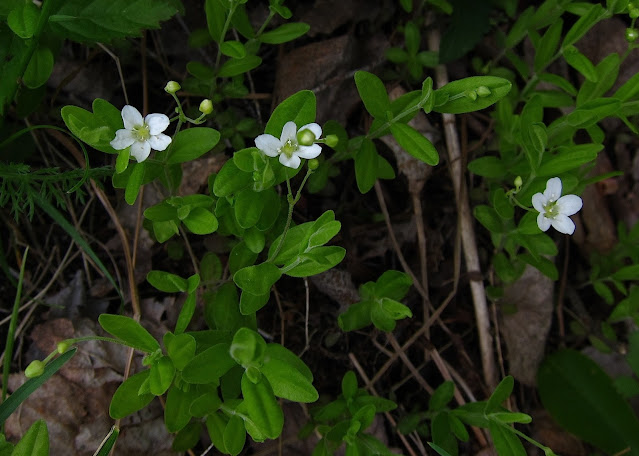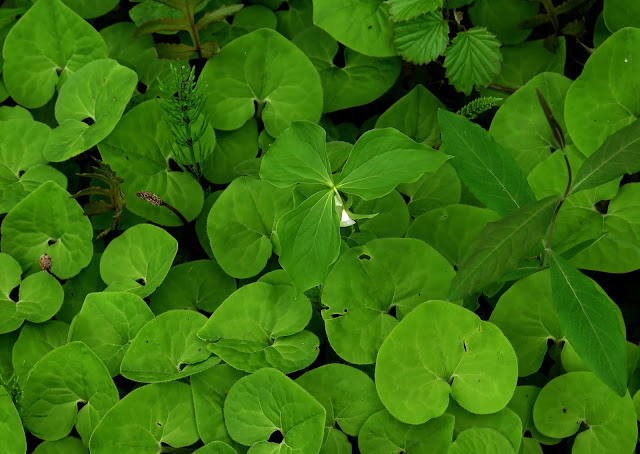A Facebook friend's post alerted me that the Nodding Trilliums (Trillium cernuum) are now blooming along Bog Meadow Brook Nature Trail in Saratoga Springs. What? Already? The last of our trilliums to bloom around here? It seems the "trillium season" just began a few days ago, although it was most likely more than six weeks ago I found the first Snow Trilliums emerging in the still-frigid woods of late March, followed a few weeks later by the Red Trilliums, then only a few days later the Large-flowered Whites. And then, having just found some Painted Trilliums in full flower, I found it hard to believe the Nodding Trilliums were already blooming. But seeing is believing, so off I went this week to see for myself.
As this photo displays, I sure couldn't see any trilliums at first sight, along this greening-up trail.
But Nodding Trilliums like to hide beneath all that trailside shrubbery. And sure enough, it didn't take more that a few yards along before my friend Sue spied the first one, well under the shrubs and about to be overtopped by Skunk Cabbage leaves. If the bright-white flower had been hiding under its own leaves (as is its habit), I doubt we would have noticed it. Happily, this was the first of many we found in perfect bloom today.
Here's the typical posture for Nodding Trillium's flower. Nodding, well beneath the leaves. Often, completely hidden.
The flower must be inverted to examine its intimate parts, noting its white ovary and dark purplish anthers held on longish filaments. By contrast, the anthers of the Red Trillium (
T. erectum) are pale, nearly white, and basically sessile to its ovary, which is dark red. Both species of trillium grow along this trail, but the Red Trilliums usually fade before the Nodding Trilliums open their flower buds. Some overlap in bloom time does occur, however, which in some years results in some interesting hybrids. (See my
post from 2019 when I first discovered some results of this gene-sharing between the two species.)
And sure enough, we found a trillium flower this day that looked as if it could be a hybrid, with nearly red petals but with a white ovary and non-sessile anthers borne on filaments. But the petals and sepals are not as retracted as would be more typical of a Nodding Trillium. A real blend, it seems, of both species.
So beautiful! I'm surprised no horticulturalists have developed such a hybrid for the commercial market.
My Facebook friend had alerted me about finding this odd trillium, advising me that I would find it beneath where a flowering crabapple tree was in bloom. And that was exactly where my friend Sue found it. And look! The crabapple's pure-white flowers were streaked with dark pink! Did that hybrid trillium growing beneath cast its magic spell on these flowers too? (Ha ha!)
As we continued our walk, I searched for -- and did find! -- this burgeoning cluster of Rose Twisted-stalk (Streptopus lanceolatus). From above, one might never guess there were tiny pink flowers dangling beneath.
The pretty flowers are certainly worth crouching down low to see. I rarely find this plant in my other Saratoga County wanderings, so I'm awfully glad I know where to find it here (as well as just one other cluster some distance away along this same trail). This species is much more common further north. (Cole's Woods in Glens Falls is a hotbed for them!)
There's one other flower I rarely encounter that grows along Bog Meadow Trail, and this was my lucky day! The wee little blooms of Grove Sandwort (Moehringia lateriflora) were just beginning to spangle the trailside grasses with multiple blooms. Although distribution maps indicate that this species is not the least bit rare in New York State, I hardly ever see it any place other than here. Such a cute little flower!
Here's a closer photo that better displays the fuzzy heart of the Grove Sandwort flower:
I was also really glad to see multitudinous developing leaves of Canada Lily (Lilium canadense) along this trail, and not yet find a single Scarlet Lily Beetle laying her eggs among them. This gorgeous native wild lily used to abound along Bog Meadow Trail before that horrid bug started eating it down to the roots each summer. Is it possible that the beetle's larvae have eaten their fill at this location and moved on? Or that the natural control (a wasp) released some years ago has managed to put a stop to the beetle's depredations? Oh boy, do I hope so!
Aren't we lucky that no pests have developed a taste for either Dog Violet (Viola labradorica) or Wild Strawberry (Fragaria virginiana)? Both native wildflowers were generously spreading their loveliness along the trail.
We saw only a single small plant of Red Baneberry (Actaea rubra) blooming today, but we walked less than half of the trail's two-mile length. I imagine more are growing in the more forested stretches further along.
Since I usually associate Wild Ginger (Asarum canadense) with calcareous habitats, I have always been surprised to find ample patches of it growing along a limited stretch of the Bog Meadow Trail (which is actually more of a wooded wetland than an actual bog habitat). And today I was doubly surprised, to see a Nodding Trillium finding a place among the ginger's big heart-shaped leaves. And look! There's a vining stem of what looks like a young Glaucous Honeysuckle seeking some vertical object to climb on, off to the right. Plus some sharply toothed Arrowwood leaves (top right) and a green-branched Field Horsetail stalk joining the wildflower party.
Too bad I didn't see this Northern Water Snake before I startled it off the path and into the trailside water. I know Sue was trying to get a photo of it curled in the grass (Sorry, Sue!) , and I was hoping to get a better look at the bulge in its length, perhaps its froggy lunch now being digested.















Of those Trillium the only ones I've seen are the white and red.
ReplyDeleteBeautiful hybrid -- if that's what it is.
ReplyDelete